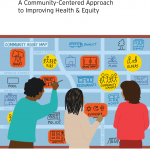By Jessica Nguyen & Patrick Glass
ChangeLab Solutions is excited to connect you with our latest resources for planners! Our recent publication The Planner’s Playbook: A Community-Centered Approach to Improving Health & Equity can help planners incorporate equity and justice considerations into their everyday practices and decisionmaking processes. In addition, our webinar recording, Planning for Equitable Investment Through Community Engagement, expands on many of the concepts introduced in The Planner’s Playbook.
Planning for an Equitable Future
As we go about our daily lives, we often take for granted the design and arrangement of our communities and neighborhoods. As we move through routine activities like commuting to work, shopping for groceries, or dropping our kids off at school, we don’t think about how every aspect of the built environment in our community was intentionally planned and decided upon.
From housing density and affordability to the location of workplaces, schools, stores, and transportation hubs, decisions made by planners and policymakers in the past have shaped the way our communities appear now. And beyond the physical appearance of districts and neighborhoods, decisions made by planners and policymakers have also heavily influenced the lives and health of the people living in our communities. These past choices have significantly affected neighborhood conditions and access to needed resources and services such as high-paying jobs and well-funded schools, financial capital for homeownership, and active transportation facilities.
Planners and policymakers do not always make decisions with justice and equity in mind. In fact, many planning decisions reinforce or exacerbate existing patterns of inequities, excluding people — primarily those in low-income or BIPOC communities — from opportunities for healthy, prosperous lives while favoring more privileged in-groups, such as more affluent white people. Present-day planners and policymakers have a responsibility to undo and replace harmful planning practices and policies that have contributed to inequitable health and wealth outcomes.
Improving the Planning Process
How, then, can planners and policymakers include equity in their everyday planning and decisionmaking processes? They can begin by examining and defining the elements of the planning process. Whether creating a long-range plan, a regional housing or transportation plan, a neighborhood-specific plan, an active transportation plan, or a climate change mitigation and adaptation plan, planners often follow a similar process.
Planners frequently start their projects by identifying and assessing the existing plans, laws, and policies that influence what they are trying to accomplish. This process might include conducting baseline assessments of existing conditions in communities and neighborhoods. A second step is developing a community vision for the plan that defines overarching goals and crafts a framework for the plan development process. A third step involves creating the new plan itself, which is then adopted by a governing body like a planning commission or city council. The final step is to execute the newly created and adopted plan, with all of the funding, accountability, and assessment considerations that are part of implementation.
Once planners are clear on what their planning process looks like, they are ready to begin changing that process to center equity. The initial assessment, for example, might benefit from close scrutiny of baseline data for omissions and hidden biases. The community-based vision might be strengthened by a more inclusive community engagement process that reflects the priorities and viewpoints of vulnerable population groups. And those who create the plan must be careful to avoid perpetuating injustices and inequities. Finally, when implementing a newly adopted plan, planners and policymakers should take clear, bold steps that address the fundamental drivers of inequities in health and wealth.
Some of these actions may require internal changes to the structure, policies, or budgets within a planner’s own organization, department, or agency. An equitable planning process may also require developing readiness and partnerships across government institutions and community stakeholders.
Guiding an Equitable Planning Process
ChangeLab Solutions’ recent publication The Planner’s Playbook: A Community-Centered Approach to Improving Health & Equity can help planners incorporate equity into their planning practices. The approach defined in the preceding section is just one part of this extensive resource; the full playbook contains many other tools and frameworks that can help planners change the status quo and do their work in an equity-informed way. Our long-term hope is that the strategies, ideas, and tools outlined in this playbook will inspire change and leadership toward healthier and more equitable communities.
The fourth episode of our virtual engagement series Uprooting the Structural Drivers of Health Inequity covers the importance of equitable community engagement in the planning process, with an emphasis on building community power at this moment in the pandemic recovery.
5/24/2021
